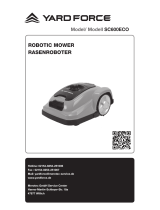
This appliance is not intended for use by persons
(including children) with reduced physical, sensory
or mental capabilities, or lack of experience and
knowledge, unless they have been given
supervision or instruction concerning use of the
appliance by a person responsible for their safety.
Children should be supervised to ensure that they
do not play with the appliance.
WARNING! This appliance can be used by
children aged from 8 years and above and
persons with reduced physical, sensory or mental
capabilities or lack of experience and knowledge if
they have been given supervision or instruction
concerning use of the appliance in a safe way and
understand the hazards involved.
Children shall not play with the appliance.
Cleaning and user maintenance shall not be made
by children without supervision.
WARNING! The robotic lawnmower can be
dangerous if used incorrectly.
WARNING! Never use the robotic lawnmower
when persons, especially children, or pets, are in
the cutting area.
Safety instructions for operation
Use
• This robotic lawnmower may only be used with the
equipment recommended by the manufacturer. All
other types of use are incorrect. The manufacturer’s
instructions with regard to operation, maintenance and
repair must be followed precisely.
• Use the HOME function or switch off the main switch
on the robotic lawnmower when persons, especially
children, or pets, are in the cutting area. If there are
persons, or pets, in the cutting area it is recommended
that the lawnmower is programmed for use during
hours when the area is free from persons, for examle
at night. See
Timer on page 23
.
• The robotic lawnmower may only be
operated, maintained, and repaired
by persons that are fully conversant
with its special characteristics and
safety regulations. Please read the
Operator’s Manual carefully and
make sure you understand the in-
structions before using the robotic
lawnmower.
• It is not permitted to modify the original design of the
robotic lawnmower. All modifications are made at your
own risk.
• Check that there are no stones, branches, tools, toys
or other objects on the lawn that can damage the
blades. Objects on the lawn can also lead to the
robotic lawnmower getting stuck in them and help may
be required to remove the object before the mower can
continue mowing.
• Start the robotic lawnmower accord-
ing to the instructions. When the
main switch is in position
1
, make
sure you keep your hands and feet
away from the rotating blades. Never
put your hands and feet under the
robotic lawnmower.
• Never lift up the robotic lawnmower or carry it around
when the main switch is in position
1
.
• Do not let persons who do not know how the robotic
lawnmower works and behaves use the robotic
lawnmower.
• The robotic lawnmower must never be allowed to
collide with persons or other living creatures. If a
person or other living creature comes in the
lawnmower’s way it shall be stopped immediately. See
Stopping on page 34
.
• Do not put anything on top of the robotic lawnmower or
its charging station.
• Do not allow the robotic lawnmower to be used with a
defective blade disc or body. Neither should it be used
with defective blades, screws, nuts or wires.
• Do not use the robotic lawnmower if the main switch
does not work.
• Always switch off the robotic lawnmower using the
main switch when the robotic lawnmower is not in use.
The robotic lawnmower can only start when the main
switch is set to
1
and the correct PIN code has been
entered.
• The robotic lawnmower must never be used at the
same time as a sprinkler. In this case use the timer
function (see
Timer on page 23
) so the mower and
sprinkler never run simultaneously.
• The built-in alarm is very loud. Be careful, especially if
the robotic lawnmower is handled indoors.
• Full compatibility cannot be guaranteed between the
robotic lawnmower and other types of wireless
systems such as remote controls, radio transmitters,
hearing loops, buried electric animal fencing or similar.
• Metal objects in the ground (for example reinforced
concrete or anti-mole nets) can result in a stoppage.
The metal objects can cause interference with the loop
signal which then can lead to a stoppage.
• The robotic lawnmower must never be used in
temperatures below 0°C. This might cause damage to
the product.
175 - 001 - 17.03.2017 7























